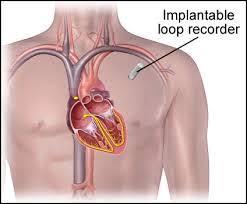 Implantable loop recorder (ILR) is a subcutaneous device designed for long-term continuous monitoring of an individual’s heart rhythm.
Implantable loop recorder (ILR) is a subcutaneous device designed for long-term continuous monitoring of an individual’s heart rhythm.It is particularly useful in the diagnostic evaluation of patients with recurrent, unexplained syncope, where an arrhythmic cause is suspected but not confirmed through conventional monitoring methods.
An implant that can record heart rhythm.
Useful to diagnose recurrent, infrequent or unexplained syncope.
Can help in the diagnosis of syncope in about 50% of cases.
The ILR can record and store electrocardiogram (ECG) data for up to three years, allowing for the detection of sporadic arrhythmias that might not be captured during shorter monitoring periods.
The device is typically implanted in a minimally invasive procedure.
it is often placed in the left pectoral region, and can be activated either automatically or by the patient during symptomatic episodes.
Its use is recommend in the early phase of evaluation for recurrent syncope and in cases of cryptogenic stroke to detect subclinical atrial fibrillation.
In patients without a diagnosis of AF, who have had cardiac implanted electronic devices, the incidence of atrial high rate episodes defined as asymptomatic atrial tachycardia with atrial rates of greater than 190 bpm which may include AF, atrial flutter and atrial tachycardia is detected as approximately 24% to 34% over one to 2 1/2 years of follow up.
Oral anicoagulation would be suggested for patients with prolonged periods of high atrial events.
